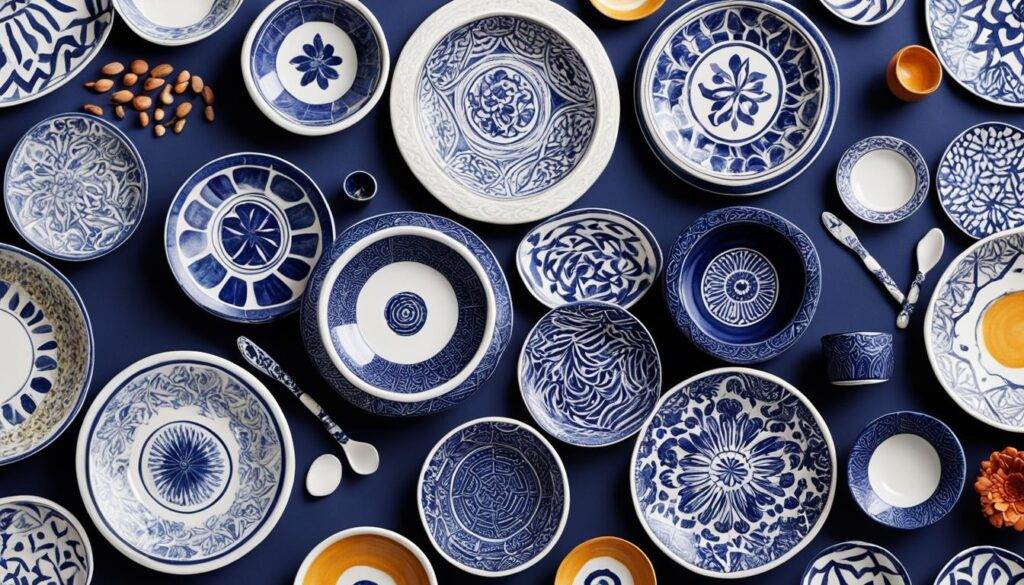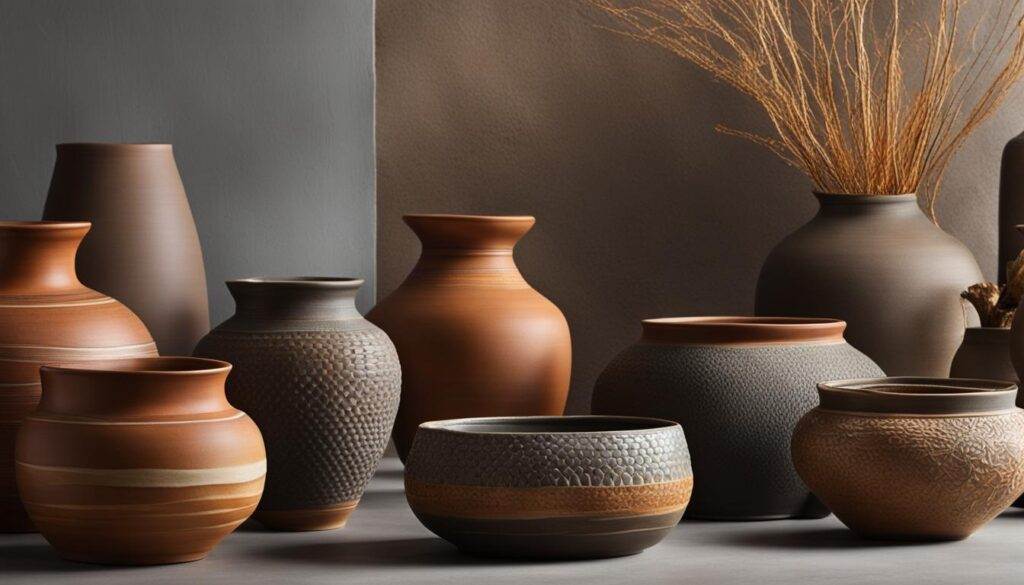Gain insights into the definition and properties of ceramics, their various types, and innovative uses in modern technology. This guide highlights the advancements in ceramic materials and their impact on multiple industries.
Understanding Ceramics- An Overview
Ceramics- Definition and Properties
Ceramics are non-metallic, inorganic materials. They are made from metallic and non-metallic elements bonded together by ionic and covalent bonds. The structure of ceramics is highly ordered, giving them unique properties.
Ceramic materials have notable mechanical properties like hardness, brittleness, and high compressive strength. Chemically, they resist corrosion and wear. These traits make ceramics essential in many applications, including construction, electronics, and medical devices.
In today’s world, ceramics are vital because of their wide range of uses. From traditional pottery to advanced engineering parts, ceramics are key to technological progress and daily life.
Classification of Ceramics by Composition
Ceramics can be grouped based on their composition into categories like oxide ceramics, carbide ceramics, nitride ceramics, and silicate ceramics.
Oxide Ceramics- Properties and Applications
Oxide ceramics such as alumina (Al₂O₃) and zirconia (ZrO₂) have excellent thermal stability and resist chemical attack. Alumina is used in electrical insulators and cutting tools due to its hardness. Zirconia is used in dental implants and oxygen sensors because it is tough and has good ionic conductivity.
Carbide Ceramics- Properties and Applications
Carbide ceramics like silicon carbide (SiC) and tungsten carbide (WC) are known for their extreme hardness and thermal conductivity. Silicon carbide is often used in abrasive materials and heating elements because it can withstand high temperatures. Tungsten carbide is found in cutting tools and wear-resistant coatings due to its durability.
Nitride Ceramics- Properties and Applications
Nitride ceramics such as silicon nitride (Si₃N₄) and aluminum nitride (AlN) offer high thermal shock resistance and mechanical strength. Silicon nitride is used in automotive engine parts because it remains tough at high temperatures. Aluminum nitride is preferred for electronic substrates due to its excellent thermal conductivity.
Silicate Ceramics- Properties and Applications
Silicate ceramics include clay products like bricks, tiles, and pottery. These materials are plastic when wet but harden upon firing. Common uses include building materials like bricks or decorative items such as pottery.
Differences Between Ceramics and Pottery
While all pottery can be considered ceramic material, not all ceramics qualify as pottery. The main difference lies in the composition; general ceramics may include advanced compositions like alumina or silicon carbide while pottery typically involves clay-based compositions.
Firing techniques also vary between the two categories. Pottery usually undergoes lower temperature firing compared to advanced technical ceramics which require higher temperatures for sintering processes.
In terms of applications, general ceramics are used across various industries from aerospace components to biomedical implants whereas pottery is mainly used for artistic or functional household items such as vases or dishes.
Advanced Applications of Ceramics
Overview of Advanced Applications in Various Industries
Advanced ceramics are materials with unique properties that make them useful in many industries. They can handle high temperatures, are lightweight, and provide excellent electrical insulation. These features make them perfect for aerospace, medical, electronics, and energy sectors.
Use of Ceramics in the Aerospace Industry
In aerospace, advanced ceramics are vital. High-temperature ceramics are used in engine parts and thermal protection systems because they can withstand extreme heat. Lightweight ceramics help make aircraft more fuel-efficient by reducing their overall weight.
Medical Applications
Ceramic components are key in the medical field. They are used to create dental implants and bone replacements because they are biocompatible and durable. Ceramic implants offer long-lasting solutions for patients needing reconstructive surgery or dental work.
Role of Ceramics in the Electronics Industry
The electronics industry relies heavily on advanced ceramics. Semiconductor ceramics are crucial for making capacitors and insulators, which are necessary for electronic devices to work properly. Additionally, ceramic materials provide thermal insulation to keep electronic components from overheating.
Energy Industry Applications
In the energy sector, ceramic materials have various uses. High-performance ceramics are found in fuel cells and solar panels due to their ability to conduct electricity while enduring high temperatures. These qualities help improve energy efficiency and sustainability.

3D Printing of Advanced Ceramics
Introduction to 3D Printing Technology for Ceramics
3D printing technology has changed how we make ceramic components. This process allows for precise control over complex shapes that would be hard to create using traditional methods.
Advantages and Benefits of Using 3D Printing for Creating Ceramic Components
The benefits of 3D printed ceramics include less material waste, quicker production times, and greater design flexibility. Engineers can create detailed designs specifically for aerospace parts, custom implants in healthcare, and rapid prototyping in manufacturing.
Specific Applications in Aerospace, Healthcare, and Manufacturing
In aerospace engineering, 3D printing helps produce complex ceramic parts that can handle extreme conditions. In healthcare, custom-made ceramic implants improve patient outcomes by offering personalized solutions. In manufacturing, rapid prototyping with 3D printed ceramics speeds up product development cycles.
Comparison Between Traditional Manufacturing Methods and 3D Printing
Traditional manufacturing methods often involve multiple steps like molding or machining which can be time-consuming and less efficient than 3D printing. In contrast, 3D printing builds parts layer-by-layer directly from digital models thus minimizing errors and reducing lead times.
Types and Applications of Ceramics
Construction
Ceramic materials are vital in construction for their durability and thermal properties. Ceramic bricks are popular in building structures due to their ability to endure harsh weather and provide excellent insulation. Ceramic tiles are used in flooring and wall coverings, offering aesthetic appeal and functional benefits like easy maintenance and moisture resistance. Sanitary ware, such as ceramic sinks and toilets, is favored for its ease of cleaning and hygiene advantages.
Abrasives
Ceramics are crucial in producing abrasives like grinding wheels and cutting tools. Grinding wheels made from abrasive ceramics are essential in material removal processes due to their hardness and sharp edges. Cutting tools crafted from these materials are used in machining operations, providing the precision needed for shaping various metals.
Refractories
Refractory ceramics are indispensable in industries that deal with high temperatures, such as metallurgy. These materials line furnaces used for molten metal containment, ensuring that the structures can withstand extreme heat without degrading. Their application extends to any environment where high thermal resistance is necessary.
Cements
Cements serve as binding agents in construction, forming strong structural elements like concrete beams and mortar joints. The ceramic components within cement contribute to its strength, making it a reliable choice for constructing durable buildings and infrastructure.

Pottery Ceramics- Art and Function
Different Types of Pottery Ceramics
Pottery ceramics include various types, each with unique characteristics:
- Bone China: Known for its translucency and strength.
- Porcelain: Valued for its fine texture.
- Stoneware: Appreciated for its durability.
Firing and Glazing Techniques
Firing techniques vary based on desired outcomes:
- Bisque Firing: An initial low-temperature firing that hardens the clay.
- High-Temperature Firing: Produces stronger ceramic pieces.
Glazing methods create different finishes on pottery items, enhancing both appearance and functionality.
Artistic and Decorative Applications
- Sculptures
- Decorative bowls
- Vases
- Wall art
Traditional and Emerging Applications of Ceramics
Ancient Uses of Ceramics
Historically, ceramics have been used extensively in ancient civilizations. Pottery artifacts such as storage vessels or cooking pots found at archaeological sites highlight their importance in daily life.
Contemporary Uses in Jewelry Fashion Design
In modern times, ceramics find applications beyond traditional uses. They are now prominent in jewelry fashion design, offering unique wearable art pieces that combine aesthetics with durability. Additionally, designer home decor items often feature ceramic elements due to their versatility and artistic appeal.
Mechanical Properties of Ceramics
Ceramics are known for their unique mechanical properties, which make them suitable for a wide range of applications. These properties include strength, stiffness, fracture toughness, ductility, creep resistance, wear resistance, impact strength, and compressive strength.
- Strength and Stiffness: Ceramics exhibit high compressive strength and stiffness. This makes them ideal for structural applications where rigidity is essential. For instance, ceramic materials are used in building materials and automotive components due to their ability to withstand significant loads without deforming.
- Fracture Toughness and Brittleness: Despite their strength, ceramics are inherently brittle. They have low fracture toughness compared to metals and polymers. This brittleness limits their use in applications where flexibility or impact resistance is required. However, advancements in ceramic composites aim to enhance fracture toughness while maintaining other desirable properties.
- Ductility and Creep Resistance: Ceramics typically lack ductility; they do not deform plastically under stress but rather crack or shatter. On the other hand, ceramics excel in creep resistance—they maintain their shape even at high temperatures over long periods. This property is crucial for components in engines and turbines that operate under extreme conditions.
- Wear Resistance: The wear resistance of ceramics makes them suitable for applications like cutting tools and bearings. Their hardness allows them to resist abrasion and maintain functionality over extended periods.
- Impact Strength: Although generally brittle, certain ceramics can absorb some impact without failing catastrophically. This property is enhanced through material engineering techniques that improve microstructure.
Chemical Properties of Ceramics
Ceramics possess distinctive chemical properties that contribute to their versatility across various industries. These properties include inertness, corrosion resistance, thermal insulation, electrical insulation, biocompatibility, reactivity, and compatibility with other materials.
- Inertness and Corrosion Resistance: One of the most significant chemical properties of ceramics is their inertness—they do not react easily with other chemicals. This makes them highly resistant to corrosion from acids, bases, salts, and other harsh chemicals. Consequently, ceramics are widely used in chemical processing equipment and containers.
- Thermal Insulation: Ceramics provide excellent thermal insulation due to their low thermal conductivity. This property makes them suitable for use as insulators in furnaces and kilns as well as in household items like cookware.
- Electrical Insulation: Many ceramics are also effective electrical insulators because they do not conduct electricity well. This characteristic is vital for electronic components such as capacitors and insulators used in power lines.
- Biocompatibility: Certain ceramics exhibit biocompatibility—meaning they can be used safely within the human body without causing adverse reactions. This makes them ideal for medical implants like dental crowns or bone substitutes.
- Reactivity and Compatibility: While generally inert under normal conditions; some advanced ceramics can be engineered to react beneficially with specific environments or substances—for example; bioactive glasses promote bone growth when implanted into the body.
Testing and Evaluation of Ceramic Properties
Testing methods for ceramics are essential to ensure quality control and predict performance accurately. These methods include both mechanical testing of ceramics and chemical testing of ceramics.
Mechanical testing involves evaluating properties such as compressive strength using standardized tests like the three-point bending test or Vickers hardness test. These tests help determine how a ceramic material will perform under different types of stress or load conditions.
Chemical testing assesses factors such as corrosion resistance by exposing samples to various chemicals over time while monitoring any changes in weight or structure. Additionally; thermal analysis techniques measure how ceramic materials respond to temperature changes—important information when designing components subjected to extreme heat or cold environments.
Quality control procedures incorporate both mechanical & chemical evaluations ensuring that only materials meeting stringent standards reach end-users—thus guaranteeing reliability & safety across all applications involving ceramic products.

